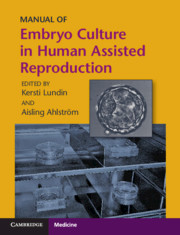Book contents
- Manual of Embryo Culture in Human Assisted Reproduction
- Cambridge Laboratory Manuals in Assisted Reproductive Technology
- Manual of Embryo Culture in Human Assisted Reproduction
- Copyright page
- Contents
- Contributors
- Preface
- Chapter 1 Facilities for Embryo Culture
- Chapter 2 Incubators for Embryo Culture
- Chapter 3 Consumables for the IVF Laboratory
- Chapter 4 Embryo Metabolism and What Does the Embryo Need?
- Chapter 5 Culture Media and Embryo Culture
- Chapter 6 Optimal Handling Techniques for Culture of Human Embryos
- Chapter 7 From Identification to Witnessing
- Chapter 8 Timing of Embryo Culture
- Chapter 9 Time-Lapse Technology
- Chapter 10 Laboratory Monitoring for Embryo Culture
- Chapter 11 Embryo Culture and IVF Offspring Outcome
- Chapter 12 The Changing Culture of Embryo Culture
- Index
- Plate Section (PDF Only)
- References
Chapter 4 - Embryo Metabolism and What Does the Embryo Need?
Published online by Cambridge University Press: 15 April 2021
- Manual of Embryo Culture in Human Assisted Reproduction
- Cambridge Laboratory Manuals in Assisted Reproductive Technology
- Manual of Embryo Culture in Human Assisted Reproduction
- Copyright page
- Contents
- Contributors
- Preface
- Chapter 1 Facilities for Embryo Culture
- Chapter 2 Incubators for Embryo Culture
- Chapter 3 Consumables for the IVF Laboratory
- Chapter 4 Embryo Metabolism and What Does the Embryo Need?
- Chapter 5 Culture Media and Embryo Culture
- Chapter 6 Optimal Handling Techniques for Culture of Human Embryos
- Chapter 7 From Identification to Witnessing
- Chapter 8 Timing of Embryo Culture
- Chapter 9 Time-Lapse Technology
- Chapter 10 Laboratory Monitoring for Embryo Culture
- Chapter 11 Embryo Culture and IVF Offspring Outcome
- Chapter 12 The Changing Culture of Embryo Culture
- Index
- Plate Section (PDF Only)
- References
Summary
The embryo is a dynamic structure that can be affected by the interaction with the surrounding environment. During its journey through the female reproductive tract from fertilization to implantation, the embryo undergoes numerous biochemical and physiological changes which are essential for a successful reproductive outcome. During successive cleavage rounds, the embryo increases in cell number, switches from maternal to embryonic genome control (embryonic genome activation; EGA) and forms cell–cell junctions. This coincides with the cells flattening and compacting at the morula stage (Coticchio et al., 2019). At the final stage of the preimplantation period, the blastomeres differentiate to form the trophectoderm and the inner cell mass cell lineages. The blastocyst undergoes remarkable events in preparation for implantation and establishment of pregnancy, including initiation of overall growth, significant rise in transcriptional activity, increased protein synthesis, and active Na+/K+ ATPase activity in the trophectoderm leading to the formation of the blastocoel cavity (reviewed by Smith & Sturmey, 2013). The blastocyst also improves homeostatic regulatory mechanisms, including defense against oxidative damage (Lane & Gardner, 2000). These changes are energy dependent, and therefore underpinned by specific metabolic pathways. Disruptions in energy production during the preimplantation period are related to embryonic developmental impairment and reduced fetal viability post-transfer (Gardner, ; Lane & Gardner, 2005b). For these reasons, metabolism is considered a key determinant of embryo competence and viability.
- Type
- Chapter
- Information
- Manual of Embryo Culture in Human Assisted Reproduction , pp. 30 - 41Publisher: Cambridge University PressPrint publication year: 2021



